An Innovative Digital Teaching Platform for Triaxial Tests on Saturated Clays: Integrating Constitutive Model Theory with Experimental Understanding
Abstract
1. Introduction
2. Fundamental Principles of Saturated Clay Constitutive Models
2.1. Anisotropic Structured Clay Model (ASCM)
2.2. Anisotropic Creep Model (ANICREEP)
3. Development of the Digital Teaching Platform
3.1. Data Input and Result Output Modules
3.2. Constitutive Model and Test Type Module
3.3. Loading Control Module
3.4. Result Display and Clear Module
4. Digital Teaching Platform Application
4.1. Case 1: Triaxial Test Simulations Using ASCM Model
4.1.1. Effect of Different Test Conditions
4.1.2. Influence of Soil Parameters
4.2. Case 2: Triaxial Test Simulations Using ANICREEP Model
4.2.1. Effect of Different Test Conditions
4.2.2. Influence of Soil Parameters
5. Conclusions
Author Contributions
Funding
Institutional Review Board Statement
Data Availability Statement
Conflicts of Interest
References
- Ishibashi, I.; Hazarika, H. Soil Mechanics Fundamentals and Applications, 2nd ed.; CRC Press: Boca Raton, FL, USA, 2015. [Google Scholar]
- Terzaghi, K.; Peck, R.B.; Mesri, G. Soil Mechanics in Engineering Practice, 3rd ed.; John Wiley & Sons: Hoboken, NJ, USA, 1996. [Google Scholar]
- Lade, P.V. Triaxial Testing of Soils; John Wiley & Sons: Hoboken, NJ, USA, 2016. [Google Scholar]
- Das, B.M. Advanced Soil Mechanics, 5th ed.; CRC Press: Boca Raton, FL, USA, 2019. [Google Scholar]
- Wood, D.M. Soil Behaviour and Critical State Soil Mechanics; Cambridge University Press: Cambridge, UK, 1990. [Google Scholar]
- Yin, Z.Y.; Hicher, P.Y.; Jin, Y.F. Practice of Constitutive Modelling for Saturated Soils; Springer Nature: Berlin/Heidelberg, Germany, 2020. [Google Scholar]
- Roscoe, K.H.; Burland, J.B. On the generalized stress–strain behavior of wet clay. In Engineering Plasticity; Herman, J., Leckie, F.A., Eds.; Cambridge University Press: Cambridge, UK, 1968; pp. 535–609. [Google Scholar]
- Wheeler, S.J.; Näätänen, A.; Karstunen, M.; Lojander, M. An anisotropic elastoplastic model for soft clays. Can. Geotech. J. 2003, 40, 403–418. [Google Scholar] [CrossRef]
- Liu, M.D.; Carter, J.P. A structured Cam Clay model. Can. Geotech. J. 2002, 39, 1313–1332. [Google Scholar] [CrossRef]
- Huang, M.; Liu, Y.; Sheng, D. Simulation of yielding and stress–stain behavior of shanghai soft clay. Comput. Geotech. 2011, 38, 341–353. [Google Scholar] [CrossRef]
- Yang, J.; Yin, Z.Y.; Liu, X.F.; Gao, F.P. Numerical analysis for the role of soil properties to the load transfer in clay foundation due to the traffic load of the metro tunnel. Transp. Geotech. 2020, 23, 100336. [Google Scholar] [CrossRef]
- Liu, J.X.; Yang, J.; Liu, Y.J.; Zhu, S.; Laouafa, F. Numerical investigation of tunnelling effects on existing piles in structured clay. Eur. J. Environ. Civ. Eng. 2022, 26, 8502–8525. [Google Scholar] [CrossRef]
- Liu, J.X.; Yin, Z.Y.; Yang, J.; Zhu, S. Implementation of a bounding surface model of structured clays in FLAC3D and numerical simulation of tunnel construction. Chin. J. Rock Mech. Eng. 2020, 39, 1277–1286. [Google Scholar]
- Yin, J.H.; Zhu, J.G.; Graham, J. A new elastic viscoplastic model for time-dependent behaviour of normally and overconsolidated clays: Theory and verification. Can. Geotech. J. 2002, 39, 157–173. [Google Scholar] [CrossRef]
- Singh, A.; Mitchell, J.K. General stress-strain-time function for soils. J. Soil Mech. Found. Div. 1968, 94, 21–46. [Google Scholar] [CrossRef]
- Adachi, T.; Oka, F. Constitutive equations for normally consolidated clay based on elasto-viscoplasticity. Soils Found. 1982, 22, 57–70. [Google Scholar] [CrossRef] [PubMed]
- Desai, C.S.; Zhang, D. Viscoplastic model for geologic materials with generalized flow rule. Int. J. Numer. Anal. Methods Geomech. 1987, 11, 603–620. [Google Scholar] [CrossRef]
- Fodil, A.; Aloulou, W.; Hicher, P.Y. Viscoplastic behaviour of soft clay. Géotechnique 1997, 47, 581–591. [Google Scholar] [CrossRef]
- Zhou, C.; Yin, J.H.; Zhu, J.G.; Cheng, C.M. Elastic anisotropic viscoplastic modeling of the strain-rate-dependent stress–strain behavior of K0-consolidated natural marine clays in triaxial shear tests. Int. J. Geomech. 2005, 5, 218–232. [Google Scholar] [CrossRef]
- Yin, Z.Y.; Chang, C.S.; Karstunen, M.; Hicher, P.Y. An anisotropic elastic–viscoplastic model for soft clays. Int. J. Solids Struct. 2010, 47, 665–677. [Google Scholar] [CrossRef]
- Yin, Z.Y.; Karstunen, M.; Chang, C.S.; Koskinen, M.; Lojander, M. Modeling time-dependent behavior of soft sensitive clay. J. Geotech. Geoenviron. Eng. 2011, 137, 1103–1113. [Google Scholar] [CrossRef]
- Yin, Z.Y.; Wu, Z.X.; Hicher, P.Y. Modeling monotonic and cyclic behavior of granular materials by exponential constitutive function. J. Eng. Mech. 2018, 144, 04018014. [Google Scholar] [CrossRef]
- Papon, A.; Riou, Y.; Dano, C.; Hicher, P.Y. Single-and multi-objective genetic algorithm optimization for identifying soil parameters. Int. J. Numer. Anal. Methods Geomech. 2012, 36, 597–618. [Google Scholar] [CrossRef]
- Knabe, T.; Datcheva, M.; Lahmer, T.; Cotecchia, F.; Schanz, T. Identification of constitutive parameters of soil using an optimization strategy and statistical analysis. Comput. Geotech. 2013, 49, 143–157. [Google Scholar] [CrossRef]
- Yin, Z.Y.; Jin, Y.F.; Shen, S.L.; Huang, H.W. An efficient optimization method for identifying parameters of soft structured clay by an enhanced genetic algorithm and elastic–viscoplastic model. Acta Geotech. 2017, 12, 849–867. [Google Scholar] [CrossRef]
- Jin, Y.F.; Yin, Z.Y.; Shen, S.L.; Hicher, P.Y. Selection of sand models and identification of parameters using an enhanced genetic algorithm. Int. J. Numer. Anal. Methods Geomech. 2016, 40, 1219–1240. [Google Scholar] [CrossRef]
- Jin, Y.F.; Wu, Z.X.; Yin, Z.Y.; Shen, J.S. Estimation of critical state-related formula in advanced constitutive modeling of granular material. Acta Geotech. 2017, 12, 1329–1351. [Google Scholar] [CrossRef]
- Jin, Y.F.; Yin, Z.Y.; Shen, S.L.; Zhang, D.M. A new hybrid real-coded genetic algorithm and its application to parameters identification of soils. Inverse Probl. Sci. Eng. 2017, 25, 1343–1366. [Google Scholar] [CrossRef]
- Yin, Z.Y.; Jin, Y.F.; Shen, J.S.; Hicher, P.Y. Optimization techniques for identifying soil parameters in geotechnical engineering: Comparative study and enhancement. Int. J. Numer. Anal. Methods Geomech. 2018, 42, 70–94. [Google Scholar] [CrossRef]
- Jin, Y.F.; Yin, Z.Y.; Zhou, W.H.; Horpibulsuk, S. Identifying parameters of advanced soil models using an enhanced transitional Markov chain Monte Carlo method. Acta Geotech. 2019, 14, 1925–1947. [Google Scholar] [CrossRef]
- Yang, J.; Jin, Y.F.; Yin, Z.Y.; Laouafa, F.; Hicher, P.Y. Identifying the parameters of a hydro-mechanical model for internal erosion occurring in granular soils by using an enhanced backtracking search algorithm. Eur. J. Environ. Civ. Eng. 2023, 27, 2325–2344. [Google Scholar] [CrossRef]
- Chen, J.F.; Chen, B.C.; Shi, Z.M.; Shen, M.R. Digital teaching platform for rock underground engineering. J. Archit. Educ. Inst. High. Learn. 2014, 23, 142–146. [Google Scholar]
- Meng, L.B.; Chen, H.Q.; Li, T.B.; Yin, H.Y. Application of PFC numerical simulation method in experimental teaching of rock mechanics. Exp. Technol. Manag. 2018, 35, 178–180+220. [Google Scholar]
- Xiao, Z.Q.; Chang, Y.B.; Lyu, Z.T.; Wang, H.; Wang, F.Q.; Deng, M.H.; Li, P.Y.; Zheng, Y.P. Application of particle flow numerical analysis software in experimental teaching of rock mechanics. Exp. Technol. Manag. 2023, 40, 199–205. [Google Scholar]
- Kadlíček, T.; Janda, T.; Šejnoha, M.; Mašín, D.; Najser, J.; Beneš, Š. Automated calibration of advanced soil constitutive models. Part I: Hypoplastic sand. Acta Geotech. 2022, 17, 3421–3438. [Google Scholar] [CrossRef]
- Kadlíček, T.; Janda, T.; Šejnoha, M.; Mašín, D.; Najser, J.; Beneš, Š. Automated calibration of advanced soil constitutive models. Part II: Hypoplastic clay and modified Cam-Clay. Acta Geotech. 2022, 17, 3439–3462. [Google Scholar] [CrossRef]
- Brinkgreve, R.B.J.; Kumarswamy, S.; Swolfs, W.M.; Foria, F. Material Model Manual; Plaxis BV: Delft, The Netherlands, 2018. [Google Scholar]
- Yin, Z.Y.; Teng, J.C.; Wang, H.L.; Jin, Y.F. A MATLAB-based educational platform for analysis of slope stability. Comput. Appl. Eng. Educ. 2022, 30, 575–588. [Google Scholar] [CrossRef]
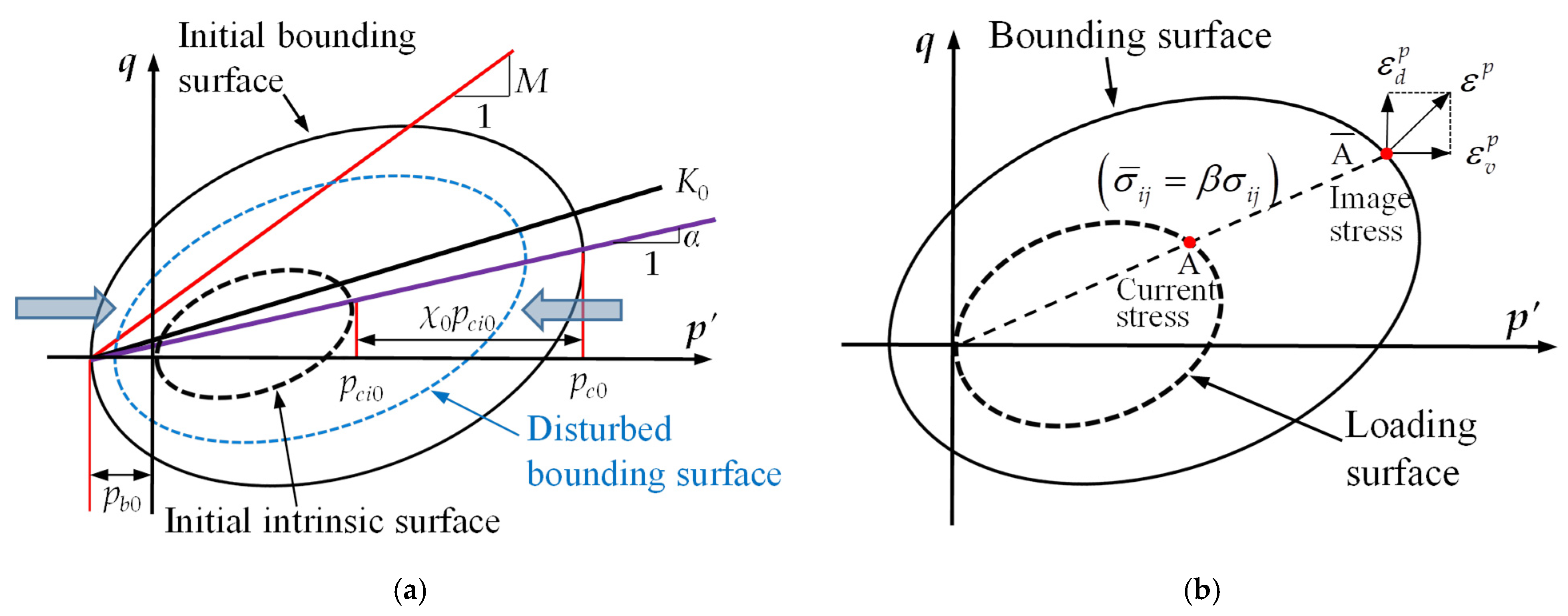


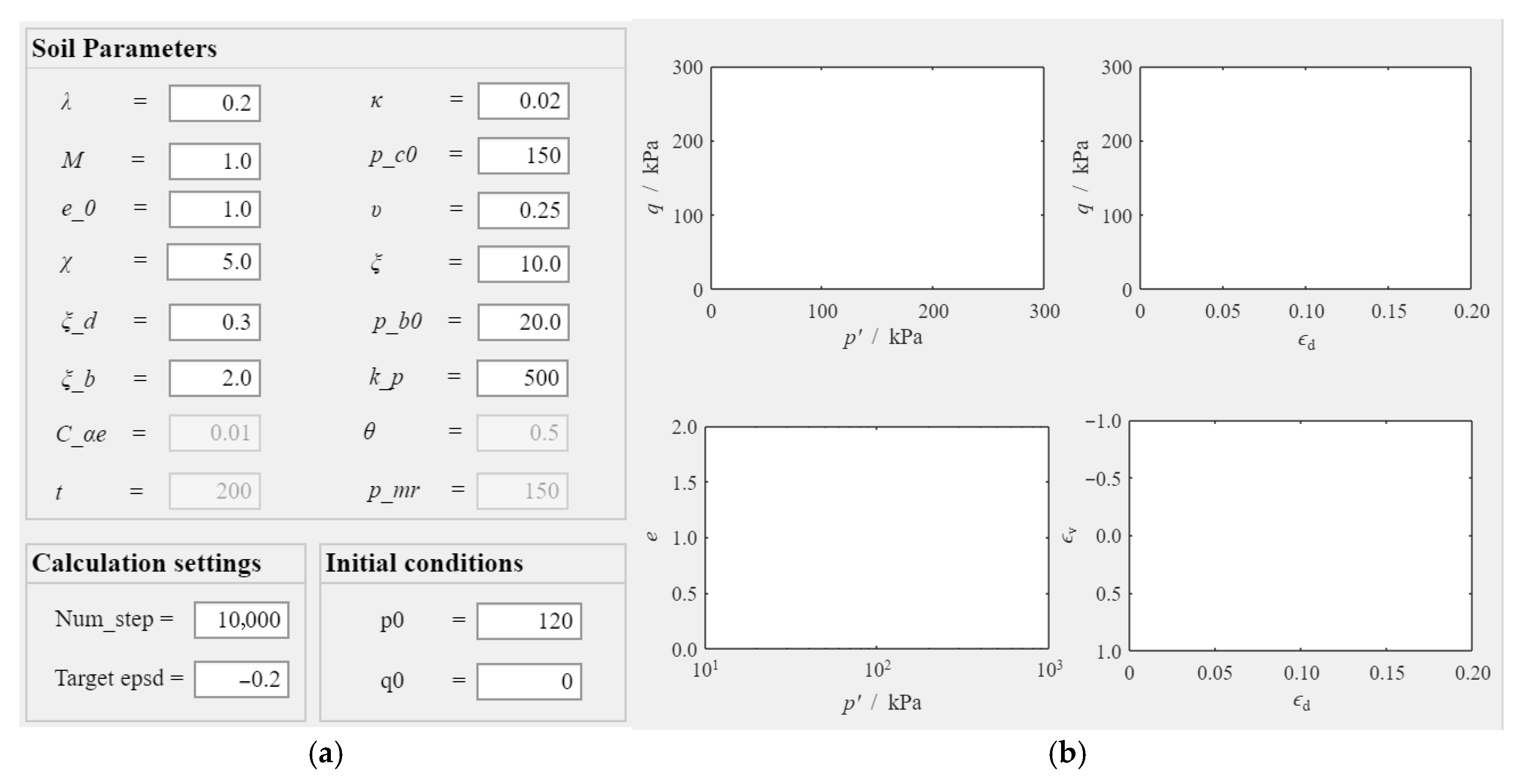
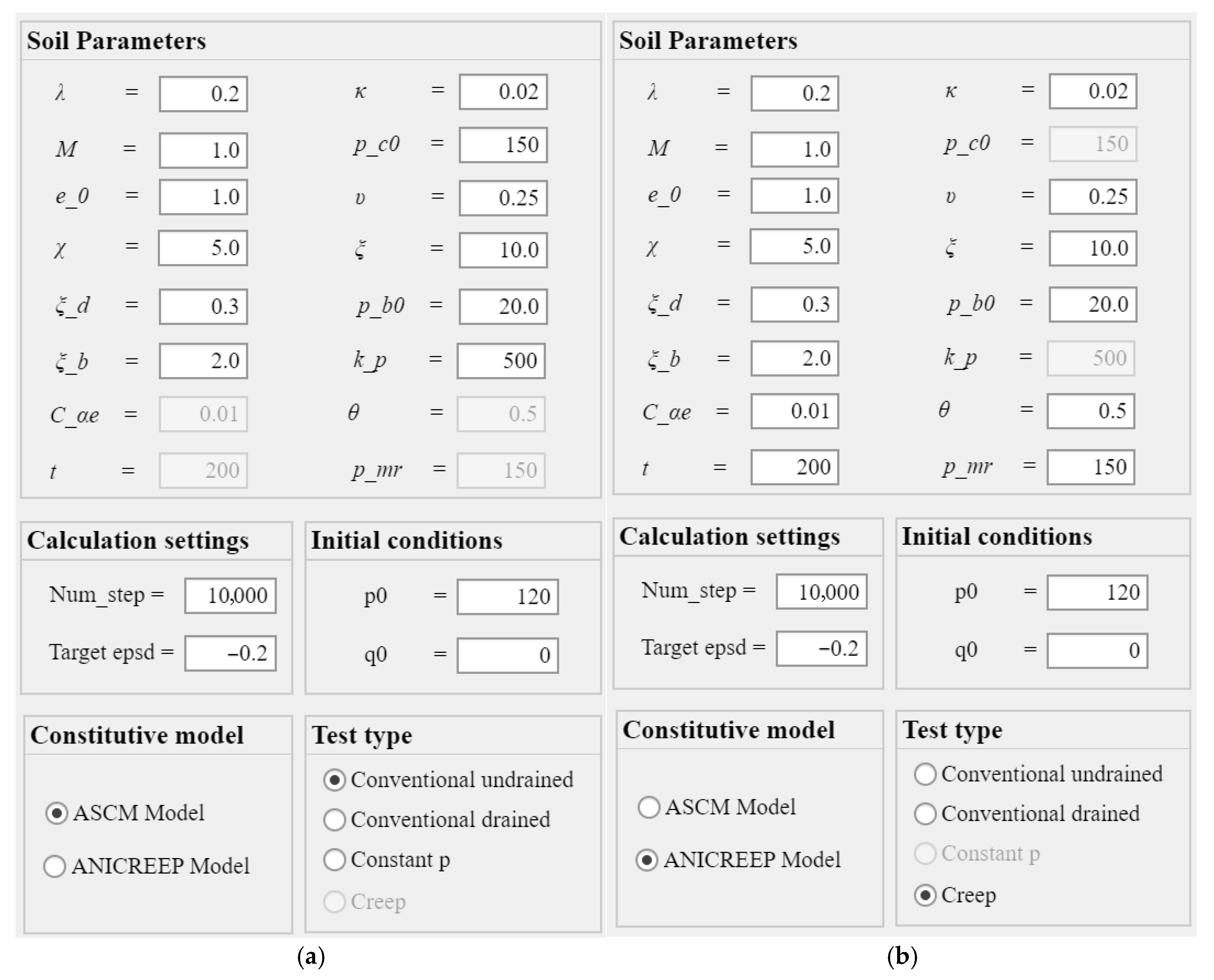


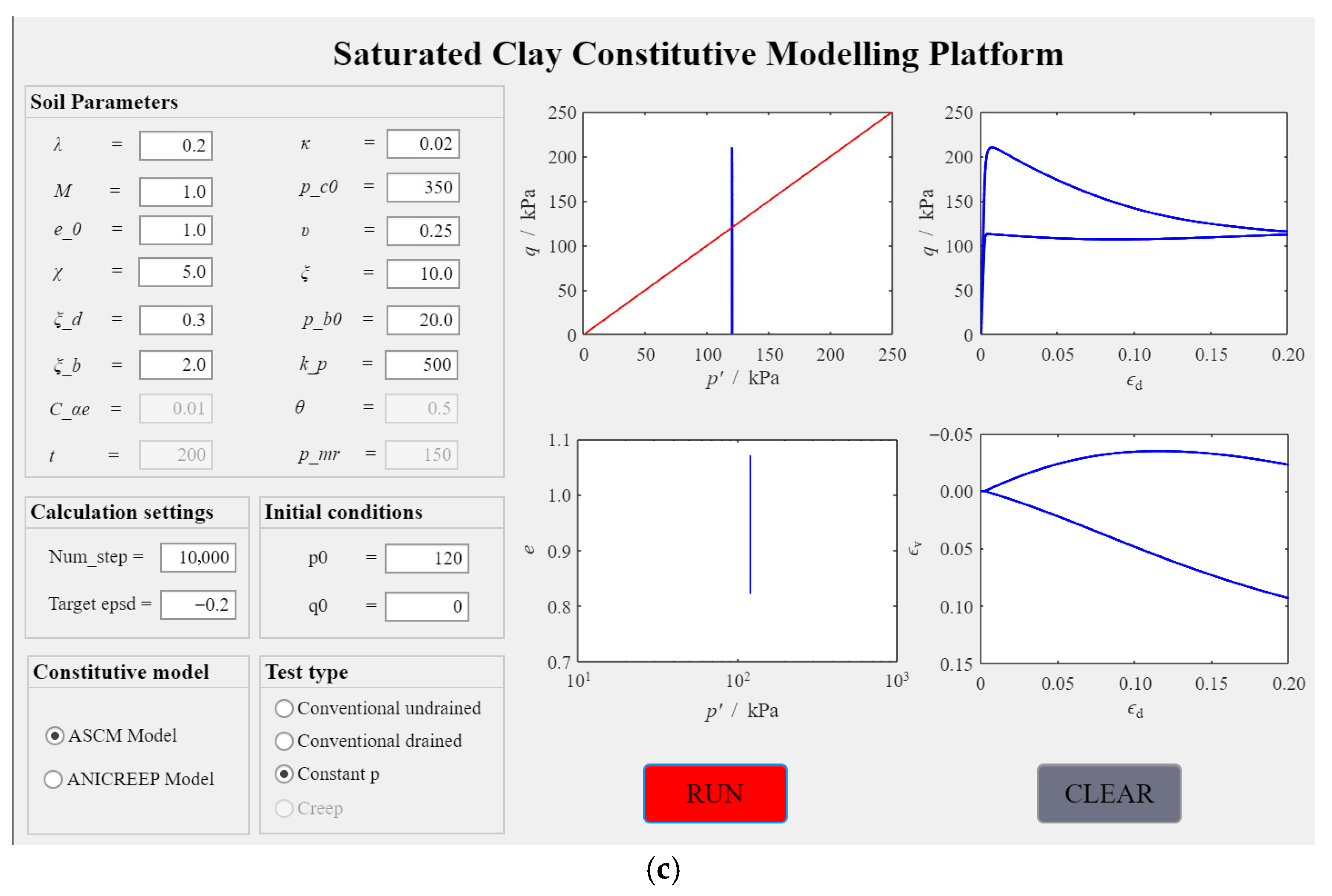
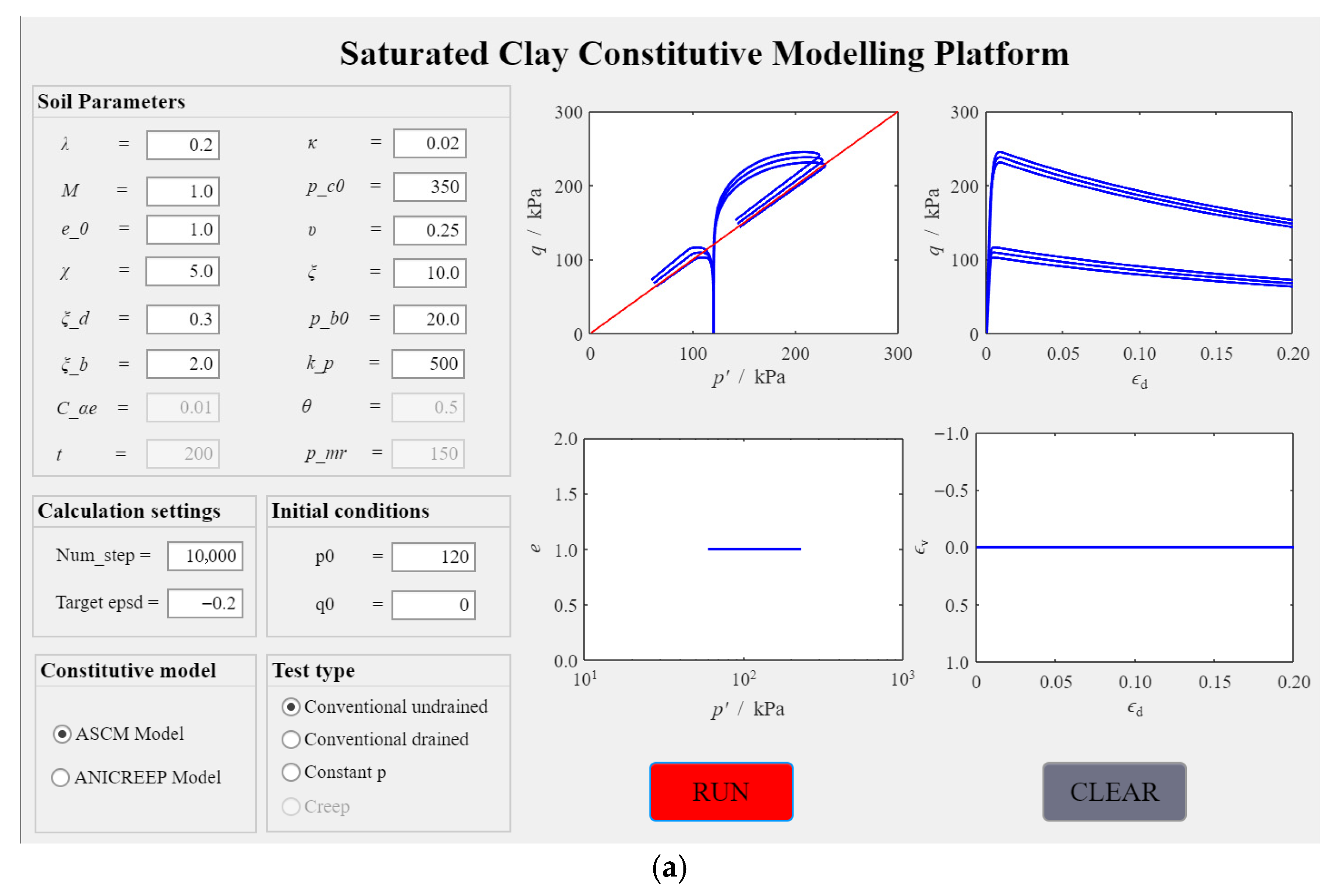


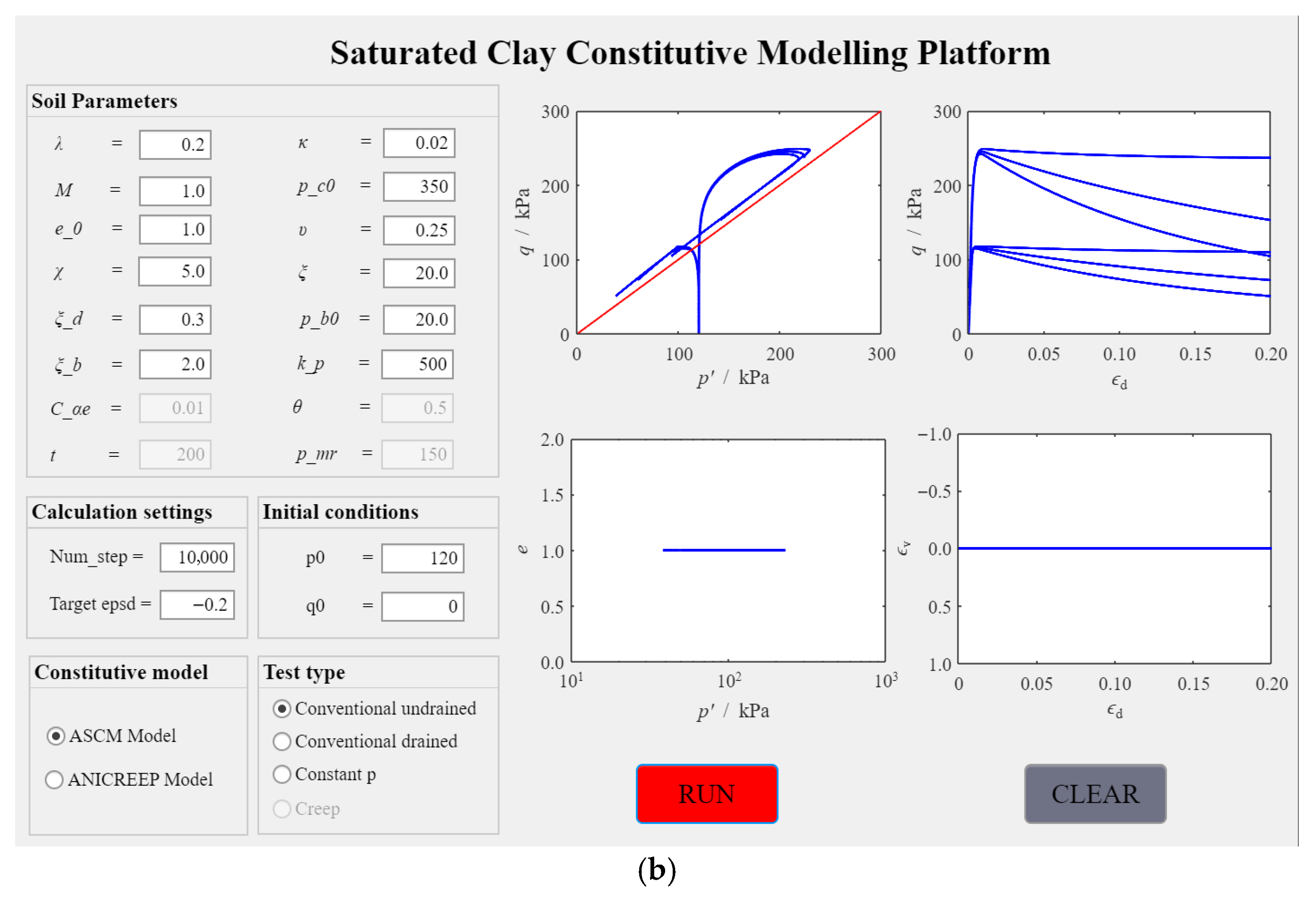

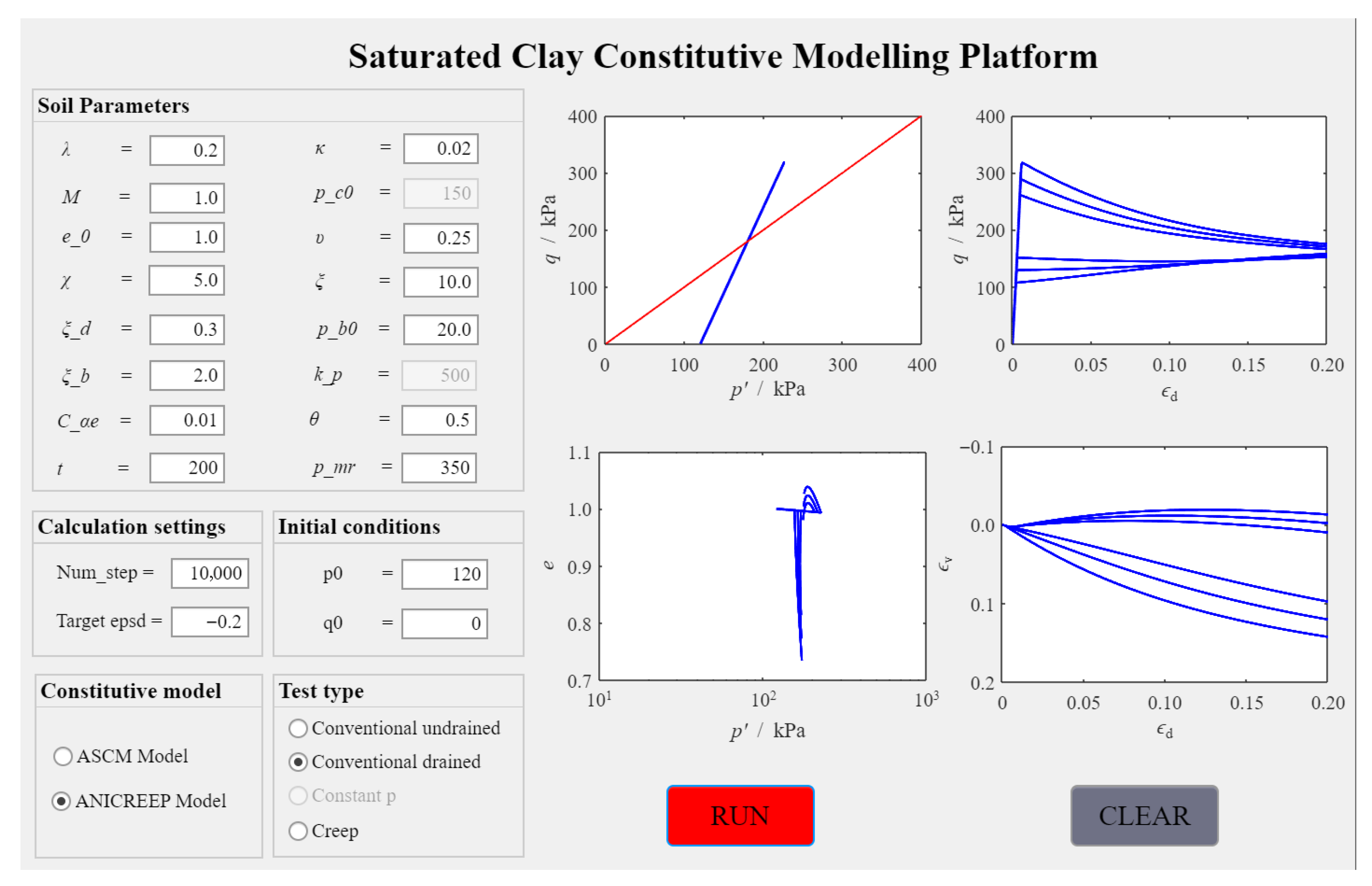
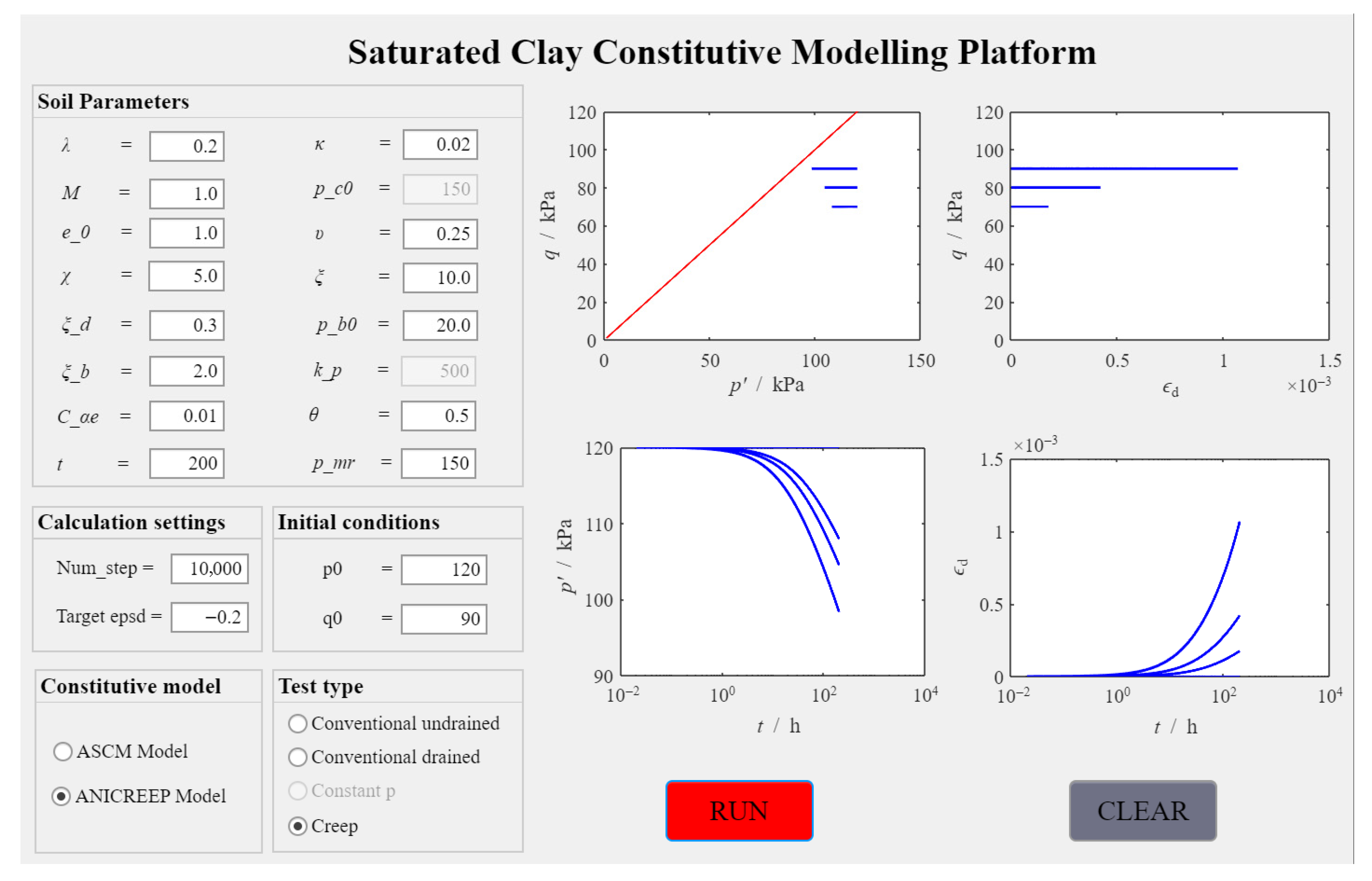
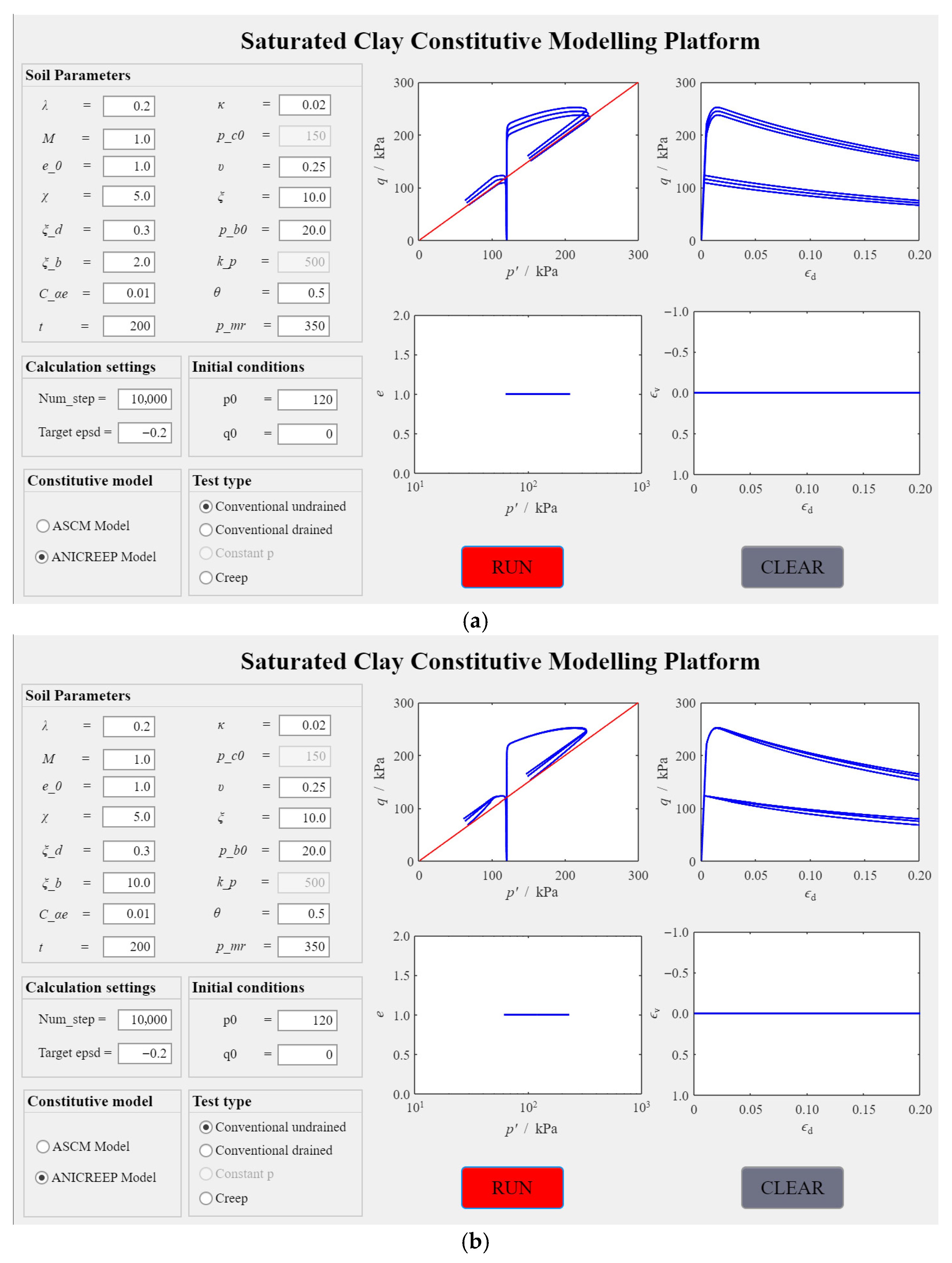

| Components. | Constitutive Equations |
|---|---|
| Hardening Rule | |
| Flow Rule |
| Parameters | Definitions |
|---|---|
| λ | Intrinsic compression index (of remolded soil) |
| κ | Intrinsic swelling index (of remolded soil) |
| M | Slope of the critical state line in the p′-q plane |
| pc0 | Initial size of the bounding surface |
| e0 | Initial void ratio |
| υ | Poisson’s ratio |
| χ0 | Initial bonding ratio |
| ξ | Degradation rate of the bonding ratio related to the plastic strain |
| ξd | Degradation rate of the bonding ratio related to the plastic deviatoric strain |
| pb0 | Initial adhesive stress |
| ξb | Degradation rate of the adhesive stress |
| kp | Plastic modulus-related parameter in the bounding surface |
| Components | Constitutive Equations |
|---|---|
| Dynamic loading surface | with |
| Reference surface | with |
| Hardening rule |
| Parameters | Definitions |
|---|---|
| λ | Intrinsic compression index (of remolded soil) |
| κ | Intrinsic swelling index (of remolded soil) |
| M | Slope of the critical state line in the p′-q plane |
| pmr0 | Initial size of the reference yield surface |
| e0 | Initial void ratio |
| υ | Poisson’s ratio |
| χ0 | Initial bonding ratio |
| ξ | Degradation rate of the bonding ratio related to the plastic strain |
| ξd | Degradation rate of the bonding ratio related to the plastic deviatoric strain |
| pb0 | Initial adhesive stress |
| ξb | Degradation rate of the adhesive stress |
| Cαe | Secondary compression coefficient |
Disclaimer/Publisher’s Note: The statements, opinions and data contained in all publications are solely those of the individual author(s) and contributor(s) and not of MDPI and/or the editor(s). MDPI and/or the editor(s) disclaim responsibility for any injury to people or property resulting from any ideas, methods, instructions or products referred to in the content. |
© 2025 by the authors. Licensee MDPI, Basel, Switzerland. This article is an open access article distributed under the terms and conditions of the Creative Commons Attribution (CC BY) license (https://creativecommons.org/licenses/by/4.0/).
Share and Cite
Liu, J.; Zha, J.; Li, K. An Innovative Digital Teaching Platform for Triaxial Tests on Saturated Clays: Integrating Constitutive Model Theory with Experimental Understanding. Technologies 2025, 13, 381. https://doi.org/10.3390/technologies13090381
Liu J, Zha J, Li K. An Innovative Digital Teaching Platform for Triaxial Tests on Saturated Clays: Integrating Constitutive Model Theory with Experimental Understanding. Technologies. 2025; 13(9):381. https://doi.org/10.3390/technologies13090381
Chicago/Turabian StyleLiu, Junxiu, Jinze Zha, and Kai Li. 2025. "An Innovative Digital Teaching Platform for Triaxial Tests on Saturated Clays: Integrating Constitutive Model Theory with Experimental Understanding" Technologies 13, no. 9: 381. https://doi.org/10.3390/technologies13090381
APA StyleLiu, J., Zha, J., & Li, K. (2025). An Innovative Digital Teaching Platform for Triaxial Tests on Saturated Clays: Integrating Constitutive Model Theory with Experimental Understanding. Technologies, 13(9), 381. https://doi.org/10.3390/technologies13090381







